Prizewinner Publication
- Dr. Gretchen Cara Daily (2009)
- Dr.Phan Nguyen Hong (2008)
- Dr. Georgina M. Mace (2007)
- Dr. Raman Sukumar (2006)
- Dr. Daniel Pauly (2005)
- Prof. Julia Carabias Lillo (2004)
- Dr. Peter H. Raven (2003)
- Prof. Anne Whiston Spirn (2001)
- Sir David Attenborough (2000)
- Dr. Wu Zheng-yi (1999)
- Dr. Jared Diamond (1998)
- Dr. Richard Dawkins (1997)
- Dr. George B. Schaller (1996)
- Dr. Tatsuo Kira (1995)
- Dr. Jacques Barrau (1994)
- Sir Ghillean T. Prance (1993)
2009 Prizewinner: Dr. Gretchen Cara Daily
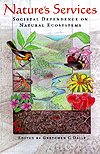
-
Nature’s Services
Societal Dependence on Natural Ecosystem.(Edited by Gretchen C. Daily)
Island press, 1997
The human race benefits from a range of ecosystem services. There are “provisioning services,” the ecosystem goods we consume directly, ,such as foodstuffs, fodder, timber, fiber, fuel, and pharmaceuticals, and “regulating services” that include climate stabilization, water purification, flood control, and pollination, among many others and so forth. However, overexploitation of ecosystems has resulted in loss of biodiversity and reduced productivity of the land, fisheries, forestry, and other natural resources.
Such destruction of nature due to the adverse effects of human activities can be temporarily forestalled through innovation in science and technology. However, if we take measures which are based on methods that can be implemented only for a limited time in a few regions, we will eventually run out of options, and the situation will worsen to the point where restoration of ecosystems is no longer possible. Therefore, we urgently need to adopt a long-term, global perspective in order to develop effective methods beyond those that can only be applied for short periods to a limited number of regions.
Conventional approaches to addressing ecosystem-related problems have been based on specialized knowledge of individual study disciplines such as sociology, economics, and politics. Accordingly, evaluation of ecosystems has tended to be one-dimensional and, therefore, inappropriate. While the importance of ecosystems is widely appreciated, their details have yet to be revealed.
Dr. Daily has edited this book by collecting and selecting studies undertaken by various natural and social scientists on these issues, as well as including her own achievements. She also wrote the introduction and conclusion. Her aim is to clarify the benefits conferred by ecosystems, and to determine their value based on appropriate evaluation criteria. She is seeking to ensure that decision-making is based on appropriate evaluation in pursuit of sustainable provision of ecosystem services, thereby securing the welfare of the human race.
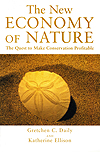
-
The New Economy of Nature
The Quest to Make Conservation ProfitableIsland press, 2002
(By Gretchen C. Daily and Katherine Ellison)
In earlier times, natural resources were regarded as inexhaustible, but it has transpired that this is not the case, given the global population explosion and growing human wants and needs. People are becoming more conscious of both the importance and the scarcity of natural resources, or assets of ecosystems. Their economic value is also becoming more significant. Because depletion of natural resources poses a threat to the livelihoods of current and future generations, we urgently need to ensure sustainable provision of nature’s benefits through conservation of natural resources.
Furthermore, we have not yet properly evaluated many of the benefits received from nature, such as the water purification and flood control effects of forests. We need to accurately measure the value of the natural resources that we have thus far not fully recognized, and protect these resources before they are lost.
Against this background, various approaches have been taken, and programs initiated toward protecting natural resources. In these efforts, academic fields such as natural sciences and economics, and practical fields such as business and politics, are regarded as being interrelated, and their integration is sought in order to construct effective models and formulate enduring legal systems. It is also stressed that conservation of natural resources should be carried out based on the understanding that such actions are not in conflict with but in harmony with economic activities, and that they can generate positive economic outcomes.
In this book, Dr. Daily presents a new guiding principle for the conservation of natural resources and offers specific examples, thereby providing models for future activity. The examples presented demonstrate compelling and pioneering endeavors: developments in which new ways of commercializing natural resources have been designed, such as trading of carbon dioxide emissions as opposed to that of direct natural resources such as timber; efforts in Costa Rica to help restore ecosystems by converting waste materials produced from fruit juice plants into fertilizer; a successful project to secure water quality in New York City by conserving the land instead of building a water treatment plant.
2008 Prizewinner: Dr.Phan Nguyen Hong
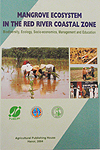
-
MANGROVE ECOSYSTEM IN THE RED RIVER COASTAL ZONE
Biodiversity, Ecology, Socio-economics, Management and Education(edited by Phan Nguyen Hong)
Agricultural Publishing House, Hanoi, 2004
Vietnam is a country where mangroves flourished and contributed to its rich biodiversity and bioresources. However, the failure to recognize the important roles that mangroves played in ecosystems resulted in their mass destruction, which threatened the livelihoods of the impoverished population living in coastal areas.
Fortunately, with assistance from NGOs and the international community, large-scale mangrove reforestation efforts have been undertaken in eight provinces of Northern Vietnam, with the result that the ecosystems have been rapidly restored.
This book is based on mangrove research conducted for years by the Mangrove Ecosystem Research Centre, Hanoi University of Education, and is highly recommended for those who wish to learn about the realities of mangrove ecosystems and environmental conservation.

-
The New Economy of Nature
The Quest to Make Conservation ProfitableIsland press, 2002
(By Gretchen C. Daily and Katherine Ellison)
Coastal and marine wetland types such as mangroves and coral reefs are characterized by rich biodiversity and play pivotal roles in sustaining the environment and the lives of local residents. Mangroves in Northern and Central Vietnam have been cut down under increasing pressure from rapid population growth, economic development, and specifically the expansion of shrimp farming. Also, coral reefs have been destroyed due to water pollution caused by coal mining and other activities.
This book is a summary report of "The role of mangrove and coral reef ecosystems in mitigating oceanic impacts on the environment," a workshop held in Hanoi in October, 2005.
2007 Prizewinner: Dr. Georgina M. Mace
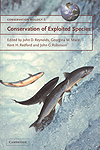
-
Conservation of Exploited Species
(edited byJohn D.Reynolds, Georgina M.Mace, Kent H.Redford and John G.Robinson)
Cambridge University Press, 2001 (ISBN 0 521 78733 5)
From the back cover“The use of wildlife for food and other human needs poses one of the greatest threats to the conservation of biodiversity.Wildlife exploitation is also critically important for subsistence and commerce to many people from a variety of cultures.This book brings together international experts to examine interactions between the biology of wildlife and the divergent goals of involved in hunting, fishing, gathering and culling wildlife.Reviews of theory show how sustainable exploitation is tied to the study of population dynamics, with direct links to reproductive rates, life histories, behaviour, and ecology.This information is used to predict the impacts of exploitation on population conservation.As such theory is rarely put into effective practice to achieve sustainable use and successful conservation, Conservation of Exploited Species explores the many reason for failure and considers remedies to tackle them, including scientific issues such as how to incorporate uncertainty into estimations, as well as social and political problems that stem from conflicting goals in exploitation.”
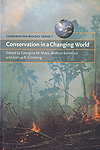
-
Conservation in a Changing World
(edited by Georgina M.Mace, Andrew Balmford andJoshua R.Ginsberg)
Cambridge University Press, 1998 (ISBN0 521 63445 8)
From the back cover“As evidence for the rapid loss of biological diversity strengthens, there is widespread recognition of the need to identify priorities and techniques for conservation action.Much progress has been made in the development of quantitative methods for identifying priority areas based on what we know about species distributions, but we must now build an understanding of biological processes into conservation planning.Here, using studies at global to local scales, researchers consider how conservation planners can deal with the dynamic interactions of species in a changing world, where human impacts will continue to affect the environment in unprecedented ways.This book will be a source of information for postgraduates, researchers and professionals in conservation biology, wildlife management and ecology.”
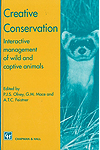
-
Creative Conservation - Interactive Management of Wild and Captive Animals
(edited by P.J.S.Olney, G.M.Mace and A.T.C.Feistner)
Chapman & Hall, 1994 (ISBN0 412 49570 8)
From the back cover“The question of the relationship between breeding endangered species in captivity and preserving and managing habitat and species in the wild is crucial to the long-term success of conservation programmes.How the captive breeding community relates to the wild, what is needed to ensure species and habitats survive and how to contribute in the future are all uppermost in the minds of those concerned to see successful outcomes to conservation efforts.
This issue was addressed at the Sixth World Conference on Breeding Endangered Species, with its theme ‘The Roles of Zoos in Global Conservation,’ held in Jersey in 1992.This book is the result of the deliberations of that important meeting.However, it is more than just a conference proceedings.The editors and contributors have further developed the key issues tackled at the conference and the resulting chapters in this book represent an update on successes and developments.It will therefore be of vital interest to all those concerned with these issues.
Via contributions from many leading experts this book presents a full review of the biological, logistical and economic concerns that exist in all efforts to manage populations.Future objectives are also given and pertinent case studies illustrate the successes and frustrations encountered.This book is a major contribution to the debate about the interactive management of populations of animals under threat of extinction.”
2006 Prizewinner: Dr.Raman Sukumar

-
The Living Elephants: Evolutionary Ecology, Behaviour, and Conservation
Oxford University Press, 2003 (ISBN 0195107780)
From the back cover“From the ancient origins of the proboscideans to the present-day crisis of the living elephants, this volume synthesizes the behavior ecology, and conservation of elephants, while covering also the history of human interactions with elephants, all within the theoretical framework of evolutionary biology.This diverse treatment includes evolution in relation to geological climate and vegetation change, extinction of mastodonts and mammoths, molecular genetics of elephants, behavioral development, communication, social organization, foraging strategies and impact on vegetation, elephant-human conflicts, and population dynamics in relation to poaching and the ivory trade.Several new interpretations are offered, as with the rise of the elephant culture in Asia or life history evolution in elephants.The volume is rounded off with a set of pragmatic recommendations for the long-term conservation of elephants in both Africa and Asia.
The broadest treatment of the subject yet undertaken, by one of the leading workers in the field, Raman Sukumar, the book promises to ring the understanding of elephants to a new level.It should be of interest not only to biologist but also to a broader audience including field ecologists, wildlife administrators, historians, sociologists, conservationists, and all those interested in elephants and their future.”

-
Elephant Days and Nights: Ten Years With the Indian Elephant
Oxford University Press (Oxford India Paperbacks), 1994(ISBN 0 19 56381 2)
From the back cover“The elephant has enjoyed a unique relationship with the people of India.It is a keystone biological species in the tropical forests across Asia, and over the past four thousand years has dominated the cultural, social and economic life of people, as no other creature.Yet elephants and people have also been in conflict; this conflict now calls for urgent solutions.
The author has been studying the life of wild elephants in southern India since 1980.This is the story of his work on elephants, their ecology, social behaviour, interactions with people, and the problems they face.His account interweaves the biology of the elephant with observations of the animal life - reproduction, feeding habits, crop raiding and manslaughter, social organization and family life, seasonal cycles, and their slaughter at the hands of ivory poachers.”

-
The Asian Elephant - Ecology and Management
Cambridge University Press, 1992 (paperback edition) (ISBN 0-521-43758-X)
From the back cover“The Asian elephant has had a unique cultural association with people for over 4000 years.Unfortunately, elephants and people have also been at conflict, resulting in the decline of elephants throughout their former range in southern Asia.This book provides an ecological analysis of elephant-human interaction and its implications for the conservation of elephants, based mainly on a study carried out in southern India.It begins with an historical perspective of the decline of elephants and summarizes their current status and major conservation issues.It then describes the interrelationship between seasonal movement and foraging in the wild.The impact of elephants on the vegetation and the controversial issue of culling in management are discussed in the Asian context.The book moves on to the interaction of elephants and people - the raiding of cultivated crops and killing of people by elephants, and the reverse process of habitat manipulation and killing of elephants by people.The impact of this interaction, in particular the selective poaching of male elephants for ivory, on the population dynamics of elephants is analyzed.The ecological data provide the basis for the recommendations on elephant conservation and management, keeping in view the socio-economic imperatives of the Asian region.This book is the first comprehensive account of Asian elephant ecology and of the interaction between people and a large, potentially destructive animal.”
2005 Prizewinner: Dr.Daniel Pauly

-
Darwin’s Fishes - An Encyclopedia of Ichthyology,Ecology and Evolution
Cambridge University Press, 2004 (ISBN 0-521-82777-9)
(http://www.cambridge.org/uk/catalogue/catalogue.asp?isbn=0521827779)
From the back cover“In Darwin’s Fishes, Daniel Pauly presents a unique encyclopedia of ichthyology, ecology and evolution, based upon everything that Charles Darwin ever wrote about fish.Entries are arranged alphabetically and can be about, for example, a particular fish taxon, an anatomical part, a chemical substance, a scientist, a place, or an evolutionary or ecological concept.Readers can start wherever they like and are then led by a series of cross-references on a fascinating voyage of interconnected entries, each indirectly or directly connected with original writings from Darwin himself.Along the way, the reader is offered interpretation of the historical material put in the context of both Darwin’s time and that of contemporary biology and ecology.
This book is intended for anyone interested in fish, the work of Charles Darwin, evolutionary biology and ecology, and natural history in general.”(Used with the permission of the publisher)

-
In a Perfect Ocean - The State of Fisheries and Ecosystemsin the North Atlantic Ocean
(Daniel Pauly and Jay Maclean)
Island Press, 2003 (ISBN 1-55963-323-9)
From the back cover“In a Perfect Ocean is the first in a series of assessments of the world’s marine ecosystem.In this first comprehensive, empirical portrait of the North Atlantic, the authors use traditional catch data and cutting-edge scientific techniques to provide an indisputable picture of an ocean whose food webs have been dramatically altered.They then explain how the North Atlantic arrived at this state, and how we can return it to health.”(Used with the permission of the publisher)
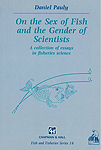
-
On the Sex of Fish and the Gender of Scientists
Chapman and Hall, 1994 (ISBN 0-412-595400)
From the back cover“Daniel Pauly is the most widely cited fisheries scientist of his generation.On the Sex of Fish and the Gender of Scientist comprises an edited and updated collection of 27 of Pauly’s essays, spanning a great range of exciting and sometimes controversial topics, many of them breaking new scientific ground.
The book is divided into four sections covering tropical and other fisheries, patterns in fish biology, overfishing and how fisheries science is implemented.There is a Foreword to the book written by Ray Hilborn and a Series Foreword introducing the book as an extremely important and valuable addition to the Chapman & Hall Fish and Fisheries Series, by Series Editor Tony Pitcher.
There is something of interest in this book for everyone involved in fisheries science and fish biology.The book should find a place on the shelves of all fisheries workers, professionals and students alike.”(Used with the permission of the publisher)
2004 Prizewinner: Prof.Julia Carabias Lillo

-
For Earth's Sake - A Report From the Commission on Developing Countries and Global Change
International Development Research Center, 1992 (ISBN 0-88936-622-5)
From the forward and the back cover“The establishment of the Commission on Developing Countries and Global Change,with support from the International Development Research Center (IDRC) and the Swedish Agency for Research Cooperation with Developing Countries (SAREC), was based on three key propositions:
- Global environmental problems have potentially catastrophic implications for many developing countries;
- Support for the participation by developing countries in dealing with these problems is lagging behind recognition of the need
for their participation; and - The biggest gap in both understanding and participation, and thus the greatest need for research support,lies in the field of
applied (both policy- and program-related) social sciences.
The first meeting of the Commission took place on Earth Day 1991.The overlap was coincidental; however, it could be regarded as symbolic in at least two ways.First, the work of the Commission of course involves the issue that is implicit in Earth Day: the environmental well-being of our planet.Second, and less evident, is the fact that Earth Day is a Northern idea, a Northern product,that is being exported to the rest of the world - not to imply that Earth Day is inappropriate; however, it must also be viewed from an alternative Southern perspective.
This book offers such a perspective and proposes a uniquely Southern agenda for research into global environmental change.It rejects the idea that we can resolve our ecological problems by simple adjustments of the economic system - or, as an economist would say, “internalizing the externalities.”Rather, it asserts that sustainable development requires more fundamental changes.The authors have dared to envision a different future.Even more importantly, they have proposed ways to reach this future that can simultaneously satisfy the demands of equity, economy, and ecology.
Global environmental issues - what are they?
Equity - the forgotten concern?
Population growth, ecological ruin - is it that simple?
Our changing planet - where is the human face?
We are confronting the most pressing challenge of our times: a planetary social and ecological crisis.The obstacles appear insurmountable, the goals, unreachable.Or are they?”(This material is reproduced here with the permission of Canada's International Development Research Centre,www.idrc.ca)
2003 Prizewinner: Dr. Peter H. Raven
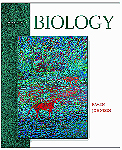
-
Biology
(Peter H. Raven and George B. Johnson)
McGraw-Hill Higher Education, 2002(ISBN 0-07-303120-8)
From the McGraw-Hill Online Learning Center“Biology is an authoritative majors textbook with evolution as a unifying theme. In revising the text, McGraw-Hill has consulted extensively with previous users, noted experts and professors in the field.It is distinguished from other texts by its strong emphasis on natural selection and the evolutionary process that explains biodiversity.Not only has the book been thoroughly updated to reflect rapid advances, there is more emphasis today on the teaching of concepts and this has led to significant changes in how the material is presented.Technology also plays a greater role in teaching and this Online Learning Center and BioCourse.com provide professors and students alike with an abundance of resources.Five considerations influenced this revision. They are: 1) Focus on concepts; 2) Reinforcing ideas; 3) Emphasizing relevance to students; 4) Keeping up with new developments; and 5) Careful editing.”

-
Biology of Plants
(Peter H. Raven, Ray F. Evertand Susan E. Eichorn)
W.H. Freeman/Worth Publisher, 1999 (ISBN 1-57259-041-6)
From the publisher’s website“Biology of Plants has long been the definitive text in introductory botany for biology majors. It is especially known for its impeccable scholarship, extensive coverage of diversity, chemical interactions, evolution and ecology, and magnificent art program. The new edition maintains the book's trademark authority, currency, and expert visuals, while offering a wealth of new information, especially in the areas of taxonomy, genomics, plant hormones, and Arabidopsis research.”
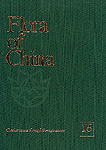
-
Biology of Plants
(Peter H. Raven, Ray F. Evertand Susan E. Eichorn)
W.H. Freeman/Worth Publisher, 1999 (ISBN 1-57259-041-6)
2001 Prizewinner: Prof. Anne Whiston Spirn

-
The Language of Landscape
Yale University Press, 1988 (ISBN 0-300-08294-0)
Based on reader input following the publication of The Granite Garden, Anne Whiston Spirn - professor of landscape architecture and regional planning at the University of Pennsylvania - decided to write a second book describing the poetics of city and nature.In the development state, she recognized that to be able to define her concepts with clarity, there was an absolute need for a language that accurately describes “landscape” to be codified.For her primary data, she relied on places.For her primary source material, she turned to “photographs and travel journals with written and drawn notes of sights, sounds, smells, and reflections”.
Professor Spirn states, “My conviction that landscape is language has startled some people and outraged others, but it seems natural to many landscape architects, for landscape is a language derived from the core activity of landscape architecture: artful shaping, from garden to region, to fulfill function and express meaning.It is a radical theory: in the sense of being rooted in the basic elements of nature and human nature; in the sense of offering a fundamentally different perspective than from any one individual root; and in demanding and enabling radical change in how we choose to think and act.”

-
The Granite Garden: Urban Nature and Human Design
BasicBooks, 1984 (ISBN 0-465-02706-7)
This book by Ann Whiston Spirn, a Harvard landscape architect, illustrates the importance of understanding how nature interacts with the physical settings of cities to create a better, more habitable urban environment.
In the preface, the author reveals, “This is a book about nature in cities and what the city could be like if designed in concert with natural processes, rather than in ignorance of them or in outright opposition.It reviews comprehensive strategies for sweeping change most readily implemented in rapidly growing cities, as well as incremental solutions more appropriate to the gradual redesign of existing urban cores.Its concentration on the look and shape of the city, especially the open space within which buildings are set, reflects the fact that its author is a landscape architect and environmental planner, not an economist or a student of government policy.”
2000 Prizewinner: Sir David Attenborough

-
The Life of Birds
BBC Books, 1998 (ISBN 0563 38792 0)
From the front flap“Birds.Over 9,000 species, the most widespread of all animals: on icebergs, in the Sahara or under the sea, at home in our gardens or flying for over a year at a time.Earthbound, we can only look and listen, enjoying their lightness, freedom and richness of plumage and song.
David Attenborough has been watching and learning all his life.His new book, with its accompanying series of films for BBC TV, is a brilliant introduction to bird behavior around the world: what they do and why they do it.He looks at each step in birds’ lives and the problems they have to solve: learning to fly; finding food; communicating; mating and caring for nests, eggs and young; migrating, facing dangers and surviving harsh conditions.
Sir David has no equal in helping others to learn and making it exciting.His curiosity and enjoyment are infectious.He shows the lifelong pleasure that birds around us offer, and how much we miss if unaware of them.”

-
The BBC Natural History Unit's Wildlife Specials
(Forward by David Attenborough)
Trident Press, 1997 (ISBN 1-900724-16-2)
From the front flap“The BBC Natural History Unit’s Wildlife Specials is based on a series of television programmes featuring six of the most charismatic animals on our planet: the polar bear, crocodile, eagle, leopard, wolf and humpback whale.
Presented by Sir David Attenborough, and filmed by award winning cameramen and producers, each Special draws upon the latest scientific research and employs sophisticated techniques to portray these superstars of the natural world in a new light, revealing aspects of their lives that have never before been filmed.
This book has been written by the people who made these unique films.People like Martha Holmes, who followed the polar bear throughout its Arctic range and whose experiences included an emergency rescue from a drifting ice floe; Michael Richards, who trekked through dense forests in the Philippines to bring back the most dramatic film of a rare monkey-eating eagle; Mike Salisbury, whose team were encircled by wild buffalo seeking to escape the snapping jaws of a wolf pack; Karen Bass, whose persistence led to new insights into the world of crocodiles; Amanda Barret who, together with her colleague Owen Newman, first penetrated the darkness with infra-red lights, to film, among other things, leopards hunting baboons; and Andy Byatt whose cameramen filmed dramatic sequences of humpback whales underwater, from the deck of their research boat and from an especially constructed, remote control airship that hovered over the whales as tightly packed groups of them burst through the surface, scooping thousands of fish into their gaping mouths.
Above all this book, and the accompanying films, are full of entertainment, drawing upon the rich canvas of nature to paint a picture that is both engaging and intriguing - a unique window into the hidden world of wildlife.Television and publishing at its best.”(Used with the permission of the publisher)
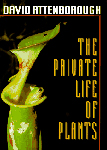
-
The Private Life of Plants
Princeton University Press, 1995 (ISBN 0-691-00639-3)
From the front flap“Based on the immensely popular six-part BBC program that will air in the U.S. and Canada during the fall of 1995, this book offers what writer/filmmaker David Attenborough is best known for delivering: a intimate view of the natural world wherein a multitude of miniature dramas unfold.In the program and book, both titled The Private Life of Plants, Attenborough treks through rainforests, mountain ranges, deserts, beaches, and home gardens to show us things we might never have suspected about the vegetation that surrounds us.With their extraordinary sensibility, plants compete endlessly for survival and interact with animals and insects: they can see, count, communicate, adjust position, strike, and capture.Attenborough makes the plant world a vivid place for readers, who in this book can enjoy the tour at their own pace, taking in the lively descriptions and nearly 300 full-color photos showing plants in fascinating detail.
The author reveals to us the aspects of plants’ lives that seem hidden from view, such as fighting, avoiding or exploiting predators or neighbors, and struggling to find food, increase their territories, reproduce themselves, and establish their place in the sun.Among the most outstanding examples, the acacia can communicate with other acacias and repel enemies that might eat their leaves, the orchid can impersonate female wasps to attract males and ensure the spreading of its pollen, the Venus’s flytrap can take other organisms captive and consume them.Covering this remarkable range of information with enthusiasm and clarity, Attenborough helps us to look anew at the vegetation on which all life depends and which has an intriguing life of its own.He has created a book sure to please the plant lover and any other reader interested in exploring the natural world.”

-
The Trials of Life - A Natural History of Animal Behavior
Little, Brown, and Company, 1990 (ISBN 0-316-05751-7)
From the front flap“David Attenborough’s brilliant new book and TNT TV series pick up where the first two left off: Life on Earth traced the development of animal life from its beginnings, and The Living Planet concentrated upon how the environment shapes the bodies of animals. Now, in The Trials of Life, David Attenborough examines how animals use those bodies - how they behave and why.
Behavior is perhaps the most obviously exciting aspect of natural history.It is full of action and drama: a killer whale surging up the beach to grab a young sea lion; an ant navigating across a Saharan sand dune by taking repeated observations of the sun; a mother bat fighting through crowds of begging infants on the roof of a cave in order to give her milk to her own baby and no other.Clearly, animal behavior might have been the first choice of subject for the three books.Yet ten years ago when David Attenborough began work on this project, he could not have witnessed many of the actions he now describes, and he certainly could not have gotten the phenomenal photographs that form the cornerstone of this volume.
Major advances in film and electronics have enabled scientists to watch animal interactions with ever-increasing accuracy: now, when they record fireflies flashing synchronously over the mangrove swamps of Malaysia, they see them not as featureless spots of light but as tiny beetles engaged in elaborate courtship rituals.Such technological advances coupled with the intensified efforts of scientists studying animals in their natural habitats have revealed fascinating and heretofore unknown behaviors.
Each chapter in The Trials of Life, like each program in the television series, looks at a different stage in the life animals.In each David Attenborough shows with dramatic and often moving examples how, from birth to death, all animals have to solve a particular set of problems if they are to survive and eventually pass their genes on to the next generation.In this last volume of the trilogy begun eleven years ago, David Attenborough, with his lucid, engaging text and choice of astonishing photographs, has produced an accessible and compelling introduction to this youngest branch of the natural sciences.”(Used with the permission of the publisher)
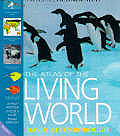
-
The Atlas of the Living World
Marshall Editions Developments Limited, 1989 (ISBN 1-84028-037-9)
From the front flap“The ever-changing patterns of life on earth are magnificently revealed in The Atlas of the Living World.It explains where plants and animals live - and why they exist where they do - and traces out the vital geographical dimensions of natural history on maps.On this cartographic foundation a team of scientists, artists and photographers has drawn together the strands of modern knowledge to create a fascinating study of the natural realm.
On a global scale, The Atlas of the Living World charts the physical forces that have shaped the earth, and the biological processes that have determined the life on our planet.Here are the stories of living continents and dying dinosaurs, epics of how the ice ages transformed the whole fauna, and tales of how new islands have been formed and populated.
Coming in closer, the environment is brought into sharp focus through its many and varied habitats.From tropical and temperate forest, through savannah and scrub, ocean shore and islands, deserts and tundra - each has its own unique identity created by living things that flourish within its boundaries.Comprising each habitat are the niches where creatures are engaged in the daily round of living, where resources must be shared, mates found, and young reared.
But the living planet is not static.Superimposed upon it are changing patterns of existence - of migration and colonization, of natural population explosions and crashes - which give the biological world its own dynamic.The arrival of humans has also affected great changes to the living environment, many of them documented, explained and evaluated here. The Atlas of the Living World reaches out to the leading edge of scientific knowledge, to unravel the vital forces that are moulding the future.In doing so, it addresses the most crucial questions of planet management into the next century.”
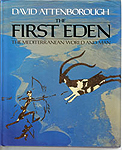
-
The First Eden - The Mediterranean World and Man
Little, Brown and Company, 1987 (ISBN 0316057509)
From the front and back flaps“Five and a half million years ago, the waters of the Atlantic flooded across an isthmus joining Morocco and Spain and into a vast trench in the earth’s crust.The resulting cataract plunged for a century or so over a cliff many miles long and fifty times higher then Niagara, until at last the basin was filled and the Mediterranean Sea had been born.No other sea, or indeed any larger-scale feature on the face of the earth, could have had such a dramatic beginning.In The First Eden, David Attenborough’s latest excursion into the field of natural history, he explores the history and current state of this fascinating region, which became the cradle of civilization.
Some three million years after the Sea had been formed, when human beings first arrived on its shores, they found rich forests teeming with game.For thousands of years thereafter, these early humans lived as wandering hunters tied to the habitats and migrations of their quarry.Then, ten thousand years ago, tribes living at the eastern end of the Sea discovered ways of taming cattle and cultivating plants and, in so doing, began a process that was to transform the whole area and ultimately the entire world.
As the human population flourished in its newfound dominion, it wrought an ever-increasing impact on the region.Arabs moved west along the southern coast and into Spain, and Crusaders traveled east to fight in the Holy Land.Each migration had its effect on the animals and plants.Later, the discovery of the New World and the cutting of the Suez Canal introduced new and exotic species.More recently, the forests have been stripped from the land and the waters polluted by oil spills and sewage.Yet even after so much destruction, wildlife still manages to survive in some parts in extraordinary richness.
In The First Eden, David Attenborough not only describes the natural history of the Mediterranean, but also tells the fascinating story of mankind’s changing attitude toward and relationship with the natural world.The Mediterranean is perhaps the oldest humanized landscape in the world, and it is here that mankind has left the most continuous, detailed and abundant evidence of its activities.What has happened here during the past millennia is, elsewhere on earth, just beginning, and by studying it closely we may obtain a better idea of where our world and its civilizations are headed.”(Used with the permission of the publisher)

-
The Living Planet
William Collins Son & Co., Ltd, 1984 (ISBN 0-00-219139-3)
From the front flap“Nowhere on our planet is devoid of life.Plants, animals and man thrive or survive within the extremes of climate and almost infinite variety of domicile which it offers.Single species, and often whole communities, adapt to make the most of ice-cap and tundra, forest and plain, desert, ocean and volcano.The adaptations are sometime extraordinary: fish which walk or lay eggs on leaves in mid-air; snakes that fly; flightless birds that graze like deer; and bears which grow hair on the soles of their feet.
In The Living Planet, based on his BBC television series, David Attenborough’s searching eye, unfailing curiosity and infectious enthusiasm, explain and illuminate the intricate lives of these colonies - from the lonely heights of the Himalayas to the wild creatures that have established themselves in the most recent of environments, the city.By the end of this book it is difficult to say which is the more astonishing - the ingenuity with which individual species contrive a living or the complexity of their interdependence on each other and the habitations provided by our planet.
As in the author’s previous book, Life on Earth, which unfolded the story of evolution, a profusion of superb photographs illustrates the principal facets of the earth’s surface and their inhabitants.”(Used with the permission of the publisher)

-
Life on Earth
William Collins Sons & Co. Ltd, 1979 (ISBN 0 00 219091-5)
From the front flap“This book, like the BBC television series on which it is based, is an attempt to give us a history of nature rather than a conventional natural history, and it is told as much as possible in terms of animals and plants alive today.The result is a pageant of life - a re-enactment of 3,500 million years of history with a cast of characters drawn from the whole range of life on earth today.
David Attenborough has received high praise for both the book and the series.This book is a permanent record of one of the most ambitious projects ever undertaken by British television as well as a standard introduction to the study of nature.”(Used with the permission of the publisher)
1999 Prizewinner: Dr. Wu Zheng-yi
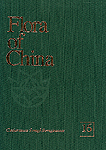
-
Flora of China Series
(Wu Zheng-yi and Peter H. Raven)
Missouri Botanical Garden Press, Science Press (ISBN 0-915279-34-7)
From the Flora of China website(http://flora.huh.harvard.edu/china/mss/intindex.htm)“The diversity of plant species in China is extraordinary.With an area almost exactly that of the continental United States, China has nearly twice as many plant species, about 31,000 or one-eighth of the world's total, versus only about 20,000 for the U.S.A. and Canada combined.This number includes about 8,000 species of medicinal and economically important plants and about 7,500 species of trees and shrubs.
The Flora of China will describe and otherwise document these species.The Flora of China is a new work, being an English-language revision of the Flora Reipublicae Popularis Sinicae (FRPS), with taxonomy reflecting the current understanding of each group.The sequence of families is a modified Englerian system, similar to that used in FRPS.All the vascular plants of China will be covered, including brief descriptions, identification keys, essential synonymy, phenology, provincial distribution in China, brief statements on extra-Chinese distribution, and remarks regarding the circumscription of problematic taxa.
In addition, botanical names, literature, geographical distribution inside and outside of China, and endemism status are available as an on-line checklist.
Close international collaboration on the research, writing, review, and editing is the hallmark of the production of the Flora.Chinese authors work together with their non-Chinese colleagues from the U.S., Canada, the United Kingdom and other European countries, Japan, Australia, and Russia. The resulting draft is then reviewed by Chinese botanists, the Flora of ChinaEditorial Committee, family specialists from around the world, and advisors on the floras of regions neighboring China to produce the best possible treatments.”(Used with the permission of the publisher)
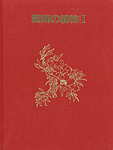
-
Wildflowers of Yunnan
Japan Broadcast Publishing Co., Ltd., 1986 (ISBN 4-14-009901-1 (0-915279-34-7))
(Printed in Chinese and Japanese)
From the forward“China’s Yunnan Province stretches from the high Tibetan steppe in the west across the subtropical hills south of the Yangtze River to the Indochina Peninsula in the southeast.The flora are distributed primarily throughout forested areas: Yunnan Provinces contains everything from tropical rainforest to alpine forest zones and, with over 13,000 species of seed-bearing plants alone, is consequently called ‘the kingdom of plants’.
In Wildflowers of Yunnan over 1,110 species of Yunnan’s native plants have been selected as representatives for their aesthetic or economic value and described in three volumes.The first volume contains species from the cold, mountainous region in the northwest, the second volume contains those species associated with the generally temperate and subtropical central and northeastern regions, and in the third volume can be found the mainly tropical species of the low-altitude, hilly southern region.
Wildflowers of Yunnan was published by the Yunnan People’s Publishing House and edited by Dr.Wu Zheng-Yi, a renowned plant taxonomist, member of the Chinese Academy of Sciences, Director of the Kunming Institute of Botany, Co-Chair of the Flora of China series, and editor of other important works, including Flora Reipublicae Popularis Sinicae.
The Japanese edition of Wildflowers of Yunnan is a cooperative effort between the Yunnan People’s Publishing House and Japan Broadcast Publishing Co., Ltd., printed and distributed in Japan.We are confident that the publishing in Japan of Wildflowers of Yunnan will considerably advance both cultural exchange and efforts for peace between China and Japan.”
1998 Prizewinner: Dr. Jared M. Diamond
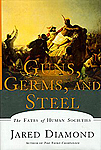
-
Guns, Germs and Steel
W.W. Norton & Company, 1997(ISBN 0-393-03891-2)
From the front and back flaps“Why did Eurasians conquer, displace, or decimate Native Americans, Australians, and Africans, instead of the reverse?In this groundbreaking book, evolutionary biologist Jared Diamond stunningly dismantles racially based theories of human history by revealing the environmental factors actually responsible for history’s broadest patterns.Here, at last, is a world history that really is a history of all the world’s peoples, a unified narrative of human life even more intriguing and important than accounts of dinosaurs and glaciers.
The story begins 13,000 years ago, when Stone-Age hunter-gatherers constituted the entire human population.Around that time, paths of development of human societies on different continents began to diverge greatly.Early domestication of wild plants and animals in the Fertile Crescent, China, Mesoamerica, the southeastern United States, and other areas gave peoples of those regions a head start.Why wheat and corn, cattle and pigs, and the modern world’s other “blockbuster” crops and livestock arose in those particular regions and not elsewhere was, until now, but faintly understood.
The localized origins of farming and herding, prove to be only part of the explanation for the differing fates of different peoples.The very unequal rates at which food production spread from those initial centers had much to do with other features of climate and geography - such as the differing sizes, locations, and even shapes of the continents.Societies that advanced beyond the hunter-gatherer stage were more likely to develop writing, technology, government, organized religions - as well as nasty germs and potent weapons of war.
It was those societies, adventuring on sea and land, that expanded to new homelands at the expense of other peoples.The most familiar examples involve the conquest of non-European peoples by Europeans in the last 500 years, beginning with voyages in search of precious metals and spices and often leading to invasion of native lands and decimation of native inhabitants through slaughter and introduced diseases.Similar population replacements, less familiar to American readers, unfolded earlier within Southeast Asia, sub-Saharan Africa, and other parts of the world.
A major advance in our understanding of human societies, Guns, Germs, and Steel chronicles the way that the modern world, and its inequalities, came to be.It is a work rich in dramatic revelations that will fascinate readers even as it challenges conventional wisdom.”(Used with the permission of W.W. Norton & Company, Inc., www.wwnorton.com)

-
Why Is Sex Fun?
BasicBooks, 1997 (ISBN 0-465-03126-9)
From the back cover“From a renowned expert in the field of physiology and author of the Pulitzer Prize-winning book Guns, Germs, and Steel comes a delightfully entertaining and enlightening look at the unique sex lives of humans.Jared Diamond answers such questions as:Why are humans one of the few species to have sex in private?Why do humans have sex any day of the month or year - including when the female is pregnant, beyond her reproductive years, or between her fertile cycles?Why are human females the only mammals to go through menopause?Why is the human penis so unnecessarily large?Why do we differ so radically in these and other important aspects of our sexuality from our closest animal relatives and ancestors?
There is no more knowledgeable or compelling authority than Diamond to answer these intriguing questions.With wit and fascinating scientific expertise, he explores the mystifying evolutionary forces that gave shape to our sexual distinctions and shows how they contributed to what it means to be uniquely human.”(Used with the permission of the publisher)

-
The Third Chimpanzee
HarperPerennial, 1992 (ISBN 0-06-098403-1)
From the back cover“Though we share 98 percent of our genes with the chimpanzee, our species evolved into something quite extraordinary.Jared Diamond explores the fascinating question of what in less than 2 percent of our genes has enabled us to found civilizations and religions, develop intricate languages, create art, learn science - and acquire the capacity to destroy all of our achievements overnight.The Third Chimpanzee is a tour de force, an iconoclastic, entertaining, sometimes alarming look at the unique and marvelous creature that is the human animal.”(Used with the permission of the publisher)
1997 Prizewinner: Dr. Richard Dawkins

-
The Extended Phenotype - The Long Reach of the Gene
Oxford University Press, 1982/1999(ISBN 0 19 288051 9)
From the Note to Oxford Paperback Edition“I suppose most scientists - most authors - have one piece of work of which they would say: It doesn’t matter if you never read anything else of mine, please at least read this.For me, it is The Extended Phenotype.In particular, the last four chapters constitute the best candidate for the title of ‘innovative’ that I have to offer.The rest of the book does some necessary sorting out on the way.Chapters 2 and 3 are replies to the criticisms of the now widely accepted ‘selfish gene’ view of evolution.The middle chapters deal with the ‘units of selection’ controversy currently fashionable among philosophers of biology, taking the gene’s-eye view; perhaps the most useful contribution here is the ‘Replicators and Vehicles’ distinction.My intention was that this piece of sorting out should put paid to the whole controversy once and for all!
As for the extended phenotype proper, I have never seen any alternative to placing it at the end of the book.Nevertheless, this policy has a disadvantage.The earlier chapters inevitably draw attention to the general ‘units of selection’ issue, and away from the more novel idea of the extended phenotype itself.It is for this reason that I have dropped the original subtitle, ‘The Gene as the Unit of Selection’, from this edition.The replacement, ‘The Long Reach of the Gene’, captures the idea of the gene as the centre of a web of radiating power.The book is otherwise unchanged apart from minor corrections.”(Used with the permission of the publisher)
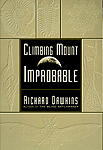
-
Climbing Mount Improbable
W.W. Norton & Company, 1997 (ISBN 0-393-03930-7)
From the back cover“How could such an intricate object as the human eye - so complex and working so precisely - have come about by chance?In writing described by the New York Times as ‘a masterpiece,’ Richard Dawkins builds a carefully reasoned and lovingly illustrated argument for evolutionary adaptation as the mechanism for life on earth.
The metaphor of ‘Mount Improbable’ represents the combination of perfection and improbability that we find in the seemingly designed complexity of living things.Dawkins skillfully guides the reader on a breathtaking journey through the mountain's passes and up its many peaks on the long, improbable path to perfection.Evocative illustrations accompany his eloquent descriptions of extraordinary adaptations such as the teeming populations of figs, the intricate silken world of spiders, and the evolution of wings on the bodies of flightless animals.And through it all runs the thread of DNA, the molecule of life, responsible for its own destiny on an unending pilgrimage through time.”(Used with the permission of W.W. Norton & Company, Inc., www.wwnorton.com)

-
The Blind Watchmaker
W.W. Norton & Company, 1996(ISBN 0-393-31570-3)
From the back cover“The watchmaker belongs to the eighteenth-century theologian William Paley, who made one of the most famous creationist arguments: Just as a watch is too complicated and too functional to have sprung into existence by accident, so too must all living things, with their far greater complexity, be purposefully designed.It was Charles Darwin’s brilliant discovery that put the lie to these arguments.But only Richard Dawkins could have written this elegant riposte to the creationists.Natural selection - the unconscious, automatic, blind, yet essentially nonrandom process that Darwin discovered - has no purpose in mind.If it can be said to play the role of watchmaker in nature, it is the blind watchmaker.
Acclaimed as perhaps the most influential work on evolution written this century, The Blind Watchmaker offers an engaging and accessible introduction to one of the most important scientific discoveries of all time.”(Used with the permission of W.W. Norton & Company, Inc., www.wwnorton.com)

-
River Out of Eden
BasicBooks, 1995 (ISBN 0-465-06990-8)
From the back cover“At last: your chance to attain scientific literacy straight from the Science Masters.
How did the replication bomb we call “life” begin and where in the world, or rather, in the universe, is it heading?Writing with characteristic wit and an ability to clarify complex phenomena (the New York Times described his style as “the sort of science writing that makes the reader feel like a genius”), Richard Dawkins confronts this ancient mystery.
Richard Dawkins is the first holder of Oxford University’s newly endowed Charles Simonyi Professorship in the Public Understanding of Science.He is the author of two acclaimed bestsellers, The Blind Watchmaker, which won both the Royal Society of Literature Award and the Los Angeles Times Book Prize in Science, and the even better known The Selfish Gene.”(Used with the permission of the publisher)

-
The Selfish Gene
Oxford University Press, 1989 (ISBN 0-19-286092-5)
From the publisher’s website“Richard Dawkins' brilliant reformulation of the theory of natural selection has the rare distinction of having provoked as much excitement and interest outside the scientific community as within it.His theories have helped change the whole nature of the study of social biology, and have forced thousands of readers to rethink their beliefs about life.
In his internationally bestselling, now classic volume, The Selfish Gene, Dawkins explains how the selfish gene can also be a subtle gene.The world of the selfish gene revolves around savage competition, ruthless exploitation, and deceit, and yet, Dawkins argues, acts of apparent altruism do exist in nature.Bees, for example, will commit suicide when they sting to protect the hive, and birds will risk their lives to warn the flock of an approaching hawk.
This revised edition of Dawkins' fascinating book contains two new chapters.One, entitled "Nice Guys Finish First," demonstrates how cooperation can evolve even in a basically selfish world.The other new chapter, entitled "The Long Reach of the Gene," which reflects the arguments presented in Dawkins' The Extended Phenotype, clarifies the startling view that genes may reach outside the bodies in which they dwell and manipulate other individuals and even the world at large.Containing a wealth of remarkable new insights into the biological world, the second edition once again drives home the fact that truth is stranger than fiction.”(By permission of Oxford University Press, www.oup.com)
1996 Prizewinner: Dr. George B. Schaller
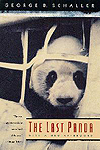
-
The Last Panda
The University of Chicago Press, 1993 (ISBN 0-226-73628-8)
From the front and back flaps (1993 edition)“Today only about 1,000 giant pandas survive in the wild.Dependent on a shrinking supply of bamboo on the one hand, and threatened by human greed and indifference on the other, the panda is at extreme risk.As recently reported in Time, a live panda can bring $112,000 on the Chinese black market.In Hong Kong, Taiwan, and Japan, black marketeers charge buyers $10,000 or more for a panda pelt.At the same time, Western zoos pay millions to rent the ever-popular pandas for exhibit.Because the panda has become a lucrative commodity, protecting it in the wild seems a near impossible task.
George Schaller and his Chinese colleagues were the first to make a detailed study of pandas in the wild.This book recounts their groundbreaking research on the panda in its dwindling native habitat and in the midst of political problems as troubling as any natural threat.Schaller forces us to confront the question: can this extraordinary creature, survivor of countless threats from nature, survive its own popularity?
In 1980, Schaller went into the mountains of Sichuan province to study the panda - a species considered a national treasure in China - on behalf of the Chinese government and the World Wildlife Fund.For over four and a half years, he and his wife, Kay, lived in the forests of the Wolong panda reserve, monitoring the lives of the pandas, recording the travels, fights, courtships, and deaths.In fog and rain and snow, over steep mountains, they tracked not only pandas but also such rare creatures as golden monkeys, red pandas, and takins.This is the story of the Schallers’ remarkable journey - told with the evocative power that is George Schaller’s gift.
But The Last Panda is more that superb natural history.It is a frank, disturbing account of good intentions gone dangerously wrong; of pandas left unprotected from poaching; of deadly traps set by poor villagers hunting within nature preserves; of the greed that drives the rent-a-panda programs; of simple bureaucratic bungling; and of the economic and political pressures that distort the priorities of international conservation efforts.
The panda, Schaller tells us, can survive.A realistic plan to save the species does exist.It is his hope that The Last Panda, so urgent and eloquent in its description of the mysterious denizens of China’s bamboo forests, will awaken the compassion that must save the panda from extinction.”(Used with the permission of the publisher)
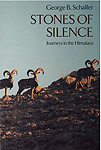
-
Stones of Silence: Journeys in the Himalaya
The University of Chicago Press, 1988(ISBN 0-226-73646-6)
From the back cover“Stones of Silence is a rare glimpse of a vanishing environment, a story told in the words of a poet yet seen through the eyes of a scientist.George B. Schaller traveled the Himalaya between 1969 and 1975 to assess the encroachment of humans on the habitat of the ibex, blue sheep, tahr, markhor, urial - the wild sheep and goats of the Himalaya.His observations of these animals and their predators and his tales of sometimes harrowing journeys to reach them form an absorbing account of a master zoologist at work, struggling to save this mountain world from turning to stones of silence.
According to the New Yorker, “A field biologist of international eminence, Schaller describes his sorties into eleven different but equally remote and hazardous sites in the mountain wilderness of Pakistan, India, and Nepal in the course of studying wildlife and searching out areas that might be suitable for nature preserves. Stones of Silence is a very considerable book - high adventure, absorbing science.”(Used with the permission of the publisher)
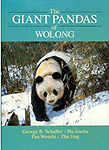
-
The Giant Pandas of Woolong
(George B. Schaller, Hu Jinchu, Pan Wenshi, Zhu Jing)
The University of Chicago Press, 1985 (ISBN 0-226-73643-1)
From the back cover“The giant panda is threatened with extinction.Only about a thousand survive in the wild in China, about half of them protected in reserves.In an effort to save this remarkable species, the government of China and the World Wildlife Fund began cooperative research in 1980.The Giant Pandas of Wolong is not only the first report of this joint venture but also the first detailed account of the panda’s natural history.It describes the environment, distribution, life cycle, and daily and seasonal activities of pandas in the wild.
Although giant pandas have few natural enemies, the periodic die-off of bamboo, their main food, threatens their survival.In order to understand the panda’s vital link to bamboo, the research team has explored many aspects of the animal’s life, collecting information on both wild and captive pandas.Though a herbivore, the panda retains the simple digestive tract of a carnivore.Unable to digest cellulose in plants, it receives relatively little nutrition from the bamboo it eats.As a result, it must eat kilograms of bamboo each day, foraging for fourteen hours or more throughout day and night.How the panda is adapted to bamboo is a basic concern of this study.
Known to the Chinese as daxiongmao, “large bear-cat,” the giant panda has defied easy classification.Is it a bear or raccoon? In an attempt to resolve this much-disputed question, the authors review anatomical, biochemical, and paleontological evidence and compare certain behavior patterns, including vocal and reproductive patterns, of giant pandas, red pandas, raccoons, bears, and other species.They conclude that the giant panda is neither bear nor raccoon but belongs in a separate family, perhaps with the small red panda.
The giant panda has captured the imagination of the public more than any other animal.By presenting their groundbreaking and crucial research to the public, the authors of The Giant Pandas of Wolong hope to spur further research and action that will help this precious animal survive.”(Used with the permission of the publisher)
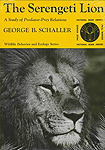
-
The Serengeti Lion
The University of Chicago Press, 1976 (ISBN 0-226-73640-7)
From the back cover“’Predators are the best wildlife managers,’ writes George Schaller.They weed out the sick and old and keep herds healthy and alert.Yet the large predators of the world have been and are still being exterminated because they are thought to harm wildlife.Schaller’s award-winning book, based on three years of study in the Serengeti National Park, describes the impact of the lion and other predators on the vast herds of wildebeest, zebra, and gazelle for which the area is famous.
The Serengeti Lion is the most intensive study ever made of the lion.The author’s field observations provide abundant data on all aspects of lion behavior, including its social system, population dynamics, hunting behavior, predation patterns, and other factors which contribute to an understanding of this great cat as a member of the natural community. The book is thoroughly illustrated with maps, charts, sketches, and fifty photographs of lions, including several shots taken of the process of killing prey.”(Used with the permission of the publisher)

-
Golden Shadows, Flying Hooves
(Midway Reprint)
Alfred A. Knopf, Inc., 1973 (ISBN 0-226-73650-4)
From the back cover“Golden Shadows, Flying Hooves is an engaging personal account of Schaller’s famous study of the Serengeti lions.It is the story not only of the lions and their prey, but also of a determined young scientist and his family, living and working in the field, compelled by their fascination with the animals and the wonder of their world.Schaller’s new Afterword reports the fate of some of the lions that the family grew to know and the research that continues in the Serengeti.”

-
The Mountain Gorilla - Ecology and Behavior
University of Chicago Press, 1963 (ISBN 0-226-73635-0)
From the front and back flaps“Few animals have stirred public and scientific interest as the gorilla has done.Discovered over a hundred years ago, it remained a creature of mystery.The gorilla has been shot, captured, and photographed, but its reputed belligerence and remote habitat discouraged firsthand scientific study.
In recent years, however, renewed emphasis on primate field behavior has sparked an intense interest in the gorilla.George Schaller’s remarkable study is the result of the African Primate Expedition (1959-60), whose prime concern was to observe the mountain gorilla in the eastern Congo and western Uganda.
Mr. Schaller’s book is the most complete study ever made of a free-living primate.C. R. Carpenter, of Pennsylvania State University, has called it an “unsurpassed field study…a classic of its type,” and William S. Laughlin, of the University of Wisconsin, predicts that it will be “a sourcebook for many years to come.”This superbly documented report describes, tabulates, analyzes, and evaluates every aspect of a gorilla’s life: its habits of eating, nesting, mating, playing; its methods of communication; and its expression of emotion, such as the chest-beating display. There are sections on population dynamics, including mortality factors, on group dynamics, and on the gorilla’s response to weather, to other animals, and to man.”(Used with the permission of the publisher)
1995 Prizewinner: Dr. Tatsuo Kira
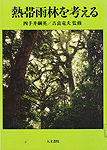
-
Thinking of Tropical Rainforests
Jimbunshoin, 1992 (ISBN 4-409-24035-8)
(Printed in Japanese)
“Tropical rainforest deforestation and desertification are unrelated.”“Logging alone won’t destroy the rainforests.”Knowing that “assertions based on a misconception of reality are harmful”, Dr. Kira began this book in order to correct such common misunderstandings.
Even if a rainforest is cut down once, its subsequent recovery is surprisingly fast.Impeding forest regeneration are unique impacts like the effect of repeated fires and land-clearing for pasture. In addition, it is thought that because logging in rainforests is ‘selective harvesting’, not clear-cutting, the forest is highly disturbed for a short time, which won’t necessarily destroy it, and the capacity for the forest environment to continue is not lost.
Developing basic viewpoints like these, a group of nine researchers, mentored by the editor, put forth their personal theories in the fields of rainforest structure and soil, mangrove ecology, peat bogs, and more.
In a symposium by the editors and writers entitled “The future of the rainforests and the world environment”, the issues are summed up, but the individual standpoints and generational differences in ways of thinking that emerge are very interesting.Despite these, however, they are all in agreement that forests are vital for the stability of the world environment (even when not considering global warming) and that accomplishing long-term forest restoration is a necessity.
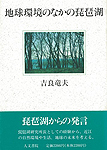
-
Lake Biwa in the World Environment
Jimbunshoin, 1990 (ISBN 4-409-24032-3)
(Printed in Japanese)
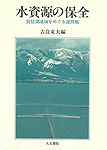
-
Conservation of Water Resources
(The Various Problems of the Lake BiwaWatershed)
Jimbunshoin, 1987 (ISBN 4-409-24025-0)
(Printed in Japanese)
In addition to ensuring water quantity, preserving the quality of water has become a pressing water resources issue.Before rainwater reaches rivers and lakes it is polluted by emissions from human activities, becoming unusable, and the high cost of processing it for use in the water supply is troubling.The causes of this loss in water quality are various, and include manmade toxins, acid rain, modern industrial discharge, and carcinogens.However, out of all these a particularly important problem is nutrification
Nutrification is the process by which nitrogen and phosphorous flow into wetlands and lakes and accumulate in the water and sediment, resulting in a decrease in animal fecundity.Nutrification initially causes rapid plankton blooms, followed by an increase in organic matter in the system, a decrease in water quality, and foul-smelling water, among other things.Nutrification not only causes changes in the types of plankton and fish, but results in an accumulation of dead plankton that settle to the bottom and decay.
During the initial stage of nutrification, the relative amount of phosphorous often plays a decisive role.Conversely, in aquatic systems with advanced nutrification, nitrogen becomes the limiting factor.The editor emphasizes that controlling the influx of these two materials is the sole, fundamental countermeasure for nutrification.To effectively instigate such a countermeasure we must carefully investigate the nature of phosphorous and nitrogen influx, and gain an adequate understanding of chemical changes in aquatic systems.

-
Tropical Forest Ecology
Jimbunshoin, 1983 (ISBN 4-409-24010-2)
(Printed in Japanese)
Tropical forests comprise 40 to 50 percent of the world’s remaining forest area.In terms of vegetation and timber cover, that ratio increases to about 60 percent.The forests are being lost at an incredibly fast rate, due to slash and burn clearing, land reclamation for mass-agriculture, logging, etc.If the forests are cut down, a huge carbon reservoir will be converted to carbon dioxide gas.Even a slight increase in the concentration of atmospheric carbon dioxide will result in a notable rise in air temperature, linking tropical forest deforestation to the single most threatening global environmental problem.
Given the average terrestrial plant biomass of three tons per hectare, and assuming roughly half of that is carbon, if 10 million hectares of tropical forest were completely burned in one year the yearly emission of carbon dioxide would be about five and a half billion tons - about 30 percent of the amount produced by burning fossil fuels.One group of ecologists estimates that, if one considers how the disappearance of forests accelerates the breakdown organic carbon in the soil, this amount increases to about the same as that resulting from the consumption of fossil fuels.The author points out that this estimate is not unreasonable.
Deforestation is also a large problem from the standpoint of tropical forests as sources of genetic diversity.It is likely that the richness of biota contained in tropical forests is connected to securing the future of evolution of life on earth.Preservation of this huge gene pool may be a necessity for the development of new types of cultivated plants and domestic animals, as well.

-
Man and the Forest - Regulation of Forest Environments
Kyouritsushuppan, 1982 (ISBN 4-320-05258-7)
(Printed in Japanese)
Material resources like timber are not the only blessings bestowed upon man by forests.Generally, we tend to forget how forests contribute in intangible ways to our preserve our lifestyles and living environment.Forests mitigate weather conditions, foster water resources, prevent natural disasters and fires, block noise, purify the atmosphere, act as environmental indices, protect animals and birds, are used for our health and recreation, provide scenic beauty, and are educational.And there are many more ways in which forests enrich and preserve our environment.
The specific benefits characteristic of forests can be classified into two groups:forests enrich our development as people, by directly affecting us both mentally and physically, and forests indirectly contribute to our health and safety, by serving to both preserve and protect their surrounding environments.
In this book, the author explains how the most important problem of today is returning the environment to its former condition, irreplaceable from the standpoint of health, education and beauty, and subsequently maintaining it as such.
Deforestation greatly effects natural environments on a global scale, and endangers our existence as well.It is even predicted that the loss of forests on a large scale will lead to the extinction of several hundred thousand species of plants in the near future.Deforestation is directly connected to overall environmental degradation, and will therefore have significant and widespread effects on our society.

-
An Ecology Primer
(Tadao Umesao, Tatsuo Kira)
Kodansha, 1976(ISBN 4-06-158078-7)
(Printed in Japanese)
From the back cover“The harmony between mankind and nature is suffering in various ways as a result of man’s rapid technological advancement.What causes things like pollution and natural disasters?Ecology, bridging the gap between biology, sociology and culture, has come to light as a required science today.At a time when we must examine things on a global scale, knowledge of pure ecology is a necessity.Answering that demand, this book is a fine work written by the foremost expert in the field, and includes an itemized description of fundamental ecological terms and a bibliography.”(Used with permission of the publisher)
1994 Prizewinner: Dr. Jacques Barrau
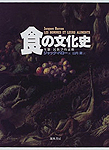
-
Men and Their Food
Chikumashobo, 1997 (ISBN 4-480-86108-4)
(Printed in Japanese, originally published in French as: Les hommes et leurs aliments, Messidor/Temps Actuels, 1983)
When the author, who became a Professor at the Paris National Museum of Natural History, was a young man of 16 during World War II, he was forcibly sent to a relocation camp.Through the harsh experience of hunger and malnutrition, he became interested in the study of food, and realized that the food-related culture is not simply based on physiological necessity, but is a product of human imagination and symbolic imagery.Through the act of consuming food, humans transformed the environment, and simultaneously defined themselves and their society.
Along these lines the author explains the cultural history of food on a large scale.This book includes the cultivation of plants and domestication of animals, the revolution of cooking with fire, the human sense of taste, changes in the flavors of food, wars over food supplies, the simultaneous existence of both hunger and excess in the present day, and food-related pathologies like overeating and refusing to eat.From a type of caviar eaten in both modern Japan and ancient Egypt to the use of beans from the new world in French stew even before Columbus’ voyage, the fascinating accounts are endless.
The author also considers the culture of food in his own country.He points out, for example, that although the French people are aware that today’s fast food had a traditional equivalent in earlier times, they are hoping for a more original, French replacement to the ubiquitous hamburger for today’s busy people.
1993 Prizewinner: Sir Ghillean T. Prance

-
Bark - The Formation, Characteristics, and Uses of Bark Around the World
(Photographs: Kjell B. Sandved,Text: Ghillean T. Prance and Anne T. Prance)
Timber Press, Inc., 1993 (ISBN 0-88192-262-5)
From the front flap“Hundreds of books have been written on trees, their flowers, leaves, and fruit, but until now none has been written with special emphasis on bark.This incredibly fascinating book detailing the formation, characteristics, and uses of bark around the world demonstrates that what we often think of as a dull, plain covering for trees is, in fact, an amazingly varied and subtly beautiful part of nature that provides humans, insects, and animals with a multitude of important products.Bark is much more than a protective covering for a tree;it is an influential part of our everyday lives.
In an easy-to-read style, the authors discuss the structure and function of bark, the unique qualities in bark that make tree identification possible, and the ingenious ways bark has adapted to a hostile environment.Separate chapters on bark-derived products - such as tannin, resin, latex, medicine and poison, various hallucinatory compounds, flavorings for food, and cork - illustrate the diverse and creative ways in which bark has been put to use.From making cloth and canoes to providing fuel and fiber, people around the world have found bark to be both beautiful and beneficial.And in the world of insects and animals, bark functions as camouflage, food, and home for a variety of creatures.”(Used with the permission of the publisher)
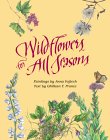
-
Wildflowers for All Seasons
Crown Publishers, 1989 (ISBN 0-517-57007-6)
From the front and back flaps“The magnificent watercolors of artist Anna Vojtech have been widely exhibited in Canada (in Montreal, Toronto, and Quebec) and in New England (in Boston, Salem, and Marblehead).She has selected 129 of the most beautiful of her works for this glorious volume of wildflowers that blossom season after season in New England’s coastal and inland areas.
For Spring she has included early Bloodroot, Blue Marsh Violet, Wild Ginger, Marsh Marigold, Mayapple, and brilliant yellow Dandelion.For Summer she introduces Mountain Laurel - the state flower of Connecticut - Yellow Goat’s Beard, False Hellebore, True Forget-Me-Not, Creeping Bellflower, Common Milkweed, Tall Buttercup, and Daylily.
Autumn is ushered in with Grass-of-Parnassus, Canada Goldenrod, Steeplebush, Pineapple Weed, Shepherd’s Purse, and Heart-leaved Aster.And finally, for the cold days of Winter, Anna pictures the fantastic shapes, forms, and colors of the dried remains of wildflowers.Here she shows Common Milkweed, Pink Lady’s Slipper, Thimbleweed, Common Cattail, Virgin’s Bower, Bull Thistle, Spreading Dogbane and Spotted Joe-Pye-Weed.
Dr. Ghillean T. Prance, the newly appointed Director of the Royal Botanic Gardens in Kew, England, has written a truly absorbing text that identifies each wildflower by genus, species, and family and plant names, along with its natural distribution range.He includes highlights and properties of each wildflower and its important medicinal values.Here is a lavish and colorful volume to be owned and cherished by nature lovers and by art collectors everywhere.”
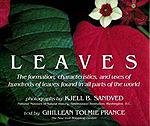
-
Leaves - The Formation, Characteristics, and Uses of Hundreds ofLeavesFound in All Parts of the World
(Photographs: Kjell B. Sandved, Text: Ghillean Tolmie Prance)
Crown Publishers, 1985 (ISBN 0-517-551527)
From the front and back flaps“Kjell Sandved, the famous photographer of the Smithsonian Institution, Washington, D.C., took more than five thousand color transparencies of leaves in his travels around the world.Three hundred in full color make up this lavish, breathtaking book.Dr. Ghillean Prance, Senior Vice-President for Science, of the New York Botanical Garden wrote the text to accompany the photographs.His authentic and highly readable prose now heralds this volume as the definitive work on the subject of leaves for years to come.
Included among the many leaf subjects that the authors cover are basic structure and shapes; veins; margins; variegated, floated, and succulent leaves; poisonous and prickly leaves that defend their plants; carnivorous plants; leaves as homes; leaf hairs; leaves of burden; modified leaves; leaves in mass; and leaves that move. Other subjects include patterns of leaf damage done by insects, useful leaves, fossil leaves, insect mimicry of leaves, and, finally, leaf collecting and the herbarium.An appendix explains the method of clearing and staining leaves and the making of leaf prints.
Some of the places in which Kjell Sandved photographed these leaves, in addition to the United States and many other regions, are England, Brazil, Colombia, Canada, Germany, Polynesia, Fiji, Java, Sabah, Sri Lanka, New Caledonia, East African countries, Australia, New Guinea, the West Indies, Costa Rica, Ecuador, New Britain Islands, and South Africa.
Every nature lover, student of botany, and photography buff will want to own and cherish this sumptuous volume as a distinguished addition to their nature library.”
